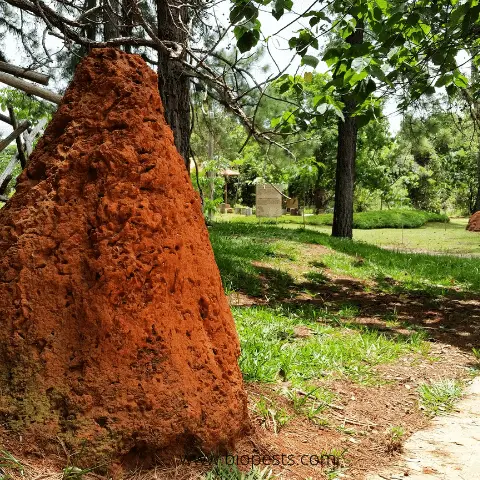Perhaps not everyone knows that termites are present everywhere and do not live only in our attics but can be nestled in the trees out in the woods, and in the soil of our gardens. There are termites that live in underground nests and they are called subterranean. They dig tunnels to reach food sources, usually woody material present in the ground and nearby (that could be beams, decks, structural wood, etc.)
These small insects live in colonies of tens of thousands of individuals comprising multiple castes that differ in appearance and function.
It often happens that while doing routine gardening work like chopping some wood, or digging among our vegetables garden, one may come across a nest of termites.
Many doubts are likely to arise: are they really termites or something else? Can they harm the vegetables? If so, how can we eradicate termites when we find them in the garden? Maybe they will remain confined in the garden and will not target our house?
Today I want to answer these and many other questions that arise about termite control, because there is so much confusion about the issue! One thing for sure is that drastic steps need to be taken for the control and prevention of these pests.
Are Termites Bad For The Garden?
As a general rule, yes. As with all insects, termites also have their own important function, which is to decompose organic matter such as deadwood. This can be beneficial to our garden since roots, stumps and buried branches can be obstacles encountered when working the soil.
If left alone, termites can grow into large colonies, causing untold damage first to your garden and then to your house.
Moreover, in the absence of food, they may attack the roots of some vegetables in our garden. Termites do not disdain broccoli, pepper roots, and tomatoes, just to name a few.
How To Get Rid Of Termites in your Garden – Naturally
It is not uncommon to find termites in the vegetable garden or even in your raised bed garden. You probably won’t be sure of what to do next, so follow these steps so you can get rid of them naturally.
- Look for other signs of termites in your yard
- Identify the insect
- Apply one or more of the natural pest controls listed below
1. Look for other signs of termite infestation in your yard
There are few unmistakable signs of the presence of termites, and these are:
- Mud tunnels:
Surely, one of the main characteristics typical of termites are the presence of mud tunnels. Termites create them by processing mud, feces and saliva, and these serve them like protected highways.
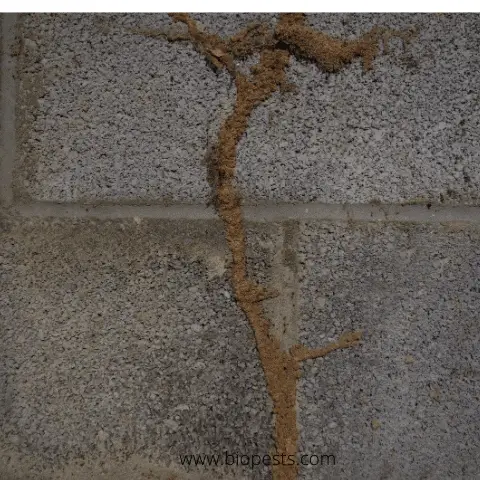
- Termite Frass
This is the name for termite droppings. If you find piles of grains that resemble salt-and-pepper-on tree stumps or near your garden shed, you can rest assured that your garden is inhabited by termites.
- Termite wings
Towards late spring and fall, their colonies produce swarms of winged termites that leave the nest looking to reproduce and create new colonies. After mating, the termites lose their wings. So if you notice piles of termite wings lying around your yard or home (they resemble small fish scales), it’s a sign that there is an infestation going on (or that you are at risk of a potential infestation). In any case, action must be taken immediately.
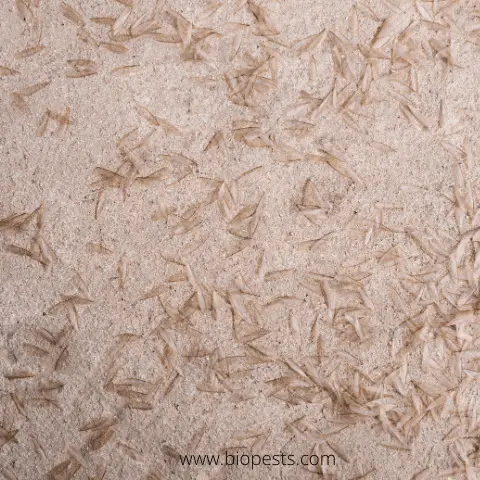
Blowholes in the trees
Termites make holes in the wood (usually exit holes) if you notice these, there is a good chance that there is a termite infestation (not to be confused with the woodworm, which I will talk about later).
- Hollow sounds
If tapping on trees you notice a dull sound, there’s a good chance the inside is empty.
- Nests on the branches or trunks of trees
Some species of termites do not live under the ground but prefer to build their nest on tree trunks or branches.
2. Identify the insect.
Know your enemy and you will know how to defeat him! So, make sure you know what you are dealing with.
Termites may look different, depending on their stage in life or their function. You are more likely to see a soldier or a worker, or a winged termite. It is very difficult to spot a king or a queen since they are kept deep, deep in the inner sanctum of their nest.
If you find termites in your garden soil, most likely they are subterranean termites These pests create colonies beneath the soil, which makes it difficult to locate and eradicate them.
They rarely emerge from soil, mud tubes, or any food sources through which they are tunneling. Termites dislike light and open air and their presence in fact, may go unnoticed until the annual swarming, when the winged adults leave the nest en masse, or up to the moment of the manifestation of the damages.
Winged termites are often confused with flying ants. These insects are so similar to each other that it is really difficult for an inexperienced eye to tell the difference but the following characteristics allow you to recognize them easily:
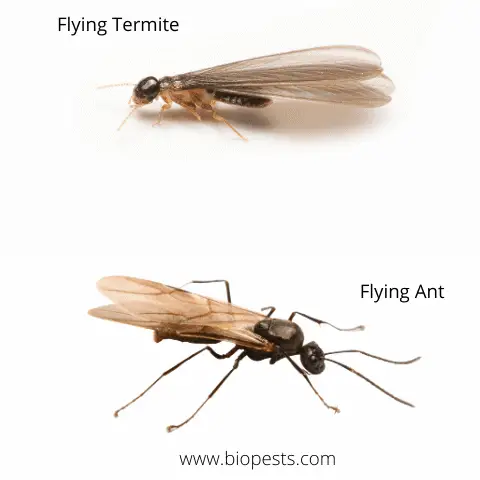
As you can see by the picture, winged termites have straight antennae, short legs, two pairs of equal wings. The length of the wings is double their bodies and they have continuous thorax-abdomen junction.
Flying ants have geniculate antennae, elongated legs, two pairs of wings of different sizes ( the front ones are larger than the rear ones) the total length of their wings is equal to the extent of the ant body. Another ant caractheristic is their “wasp waist”.
Another insect that could confuse us is the woodworm. Woodworms are boring wood beetle larvae. They feed on dead wood and thrive in humid places.
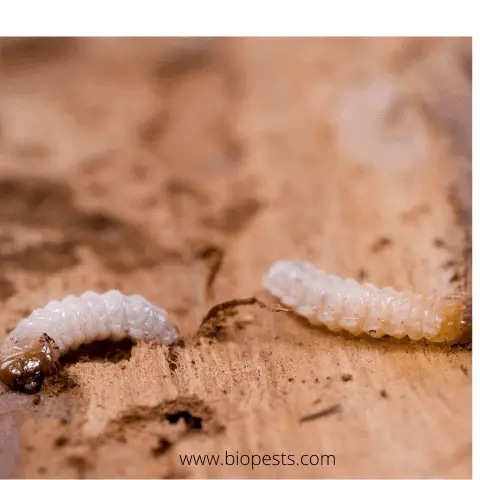
Wood boring beetles lay their eggs on wooden surfaces, furniture, and trees. When the eggs hatch, the larvae begin to eat the wood until they reach the adult stage and leave. As they eat the wood, they create pores on the surface of the wood.
It is likely that if we have a wooden garden shed we can find the characteristic holes left by woodworms. (Termites eat wood from the inside leaving the most superficial layers of the wood completely intact. They do not leave holes ).
We can find woodworms in open areas or where there are dead or fallen trees, garden sheds, wherever there is wood and with humid conditions.
Apply these natural pest controls for termites listed below:
First of all, resist the temptation of grabbing a pesticide to spray directly on the termites.
Chances are that the termites that you are seeing are far away from their nest and killing a few won’t solve your problem. Termites are social animals and live in huge colonies. The best way to kill them is by turning their social skills in our favor: for example by using baits with poison. They will take the baits to their nest and feed the rest of the colony with the poison.
- Use Beneficial Nematodes
Release beneficial nematodes to the soil in the proximity of the termite nest. These microscopic parasitic worms will hunt and kill parasites found in a humid and dark environment. Nematodes are one of the best ways to destroy an infestation without affecting our health. They are 100% natural and pesticide-free! The use of nematodes is perhaps the safest type of control available. Nematodes are not destructive to wood and pose no health risk to people or pets. Here is an article about these amazing microscopic worms.
Nematodes can be found in multiple home and garden stores. The most suitable species for killing termites is Steinernema Carpocapse Nematodes (SC). The application is easy and any homeowner can handle it. Just make sure the nematodes you are applying are well and alive and that the soil is moist enough (that will facilitate their job). You should see the first results in about a week to ten days after the application.
- Apply some borax powder
Sodium borate, known as borax powder, can kill termites by interfering with their digestion, which will eventually lead to their death. This fine powder sticks to the legs, antennae, and bodies of the termites and acts as a poison when consumed during grooming.
Sprinkle the powder around the affected area, in cracks, crevices, and other insect hiding places. As an alternative, you can mix it with water and spray it into the infested area. Reapply in case of need.
- Apply Orange Oil Spray
Orange oil is derived from orange peels and can be purchased in DIY or gardening stores, as well as online. Orange oil causes termites exoskeletons to melt, killing them. Spray the oil directly on termites or areas where you suspect they are termites. You can also spray the oil to deter termites from entering the area, and regularly spray it in garden sheds and in your home. It is a great preventative measure. Repeat the application from time to time.
- Apply Diatomaceous Earth
Diatomaceous Earth is also known as D.E. and it is the fossilized remains of diatoms, a type of hard-shelled protists. It comes in a crumbled white powder. It is largely considered harmless to people and is a safe alternative to pesticides. It is usually used in the garden, however, you can use it indoors with caution. The tiny particles will kill the termites within 48 hours by dehydrating them to death. Keep the product away from children.
- Use Apple Cider Vinegar
Did you know that among the many uses of apple cider vinegar, you can also use it as a natural pesticide? It seems to be the panacea for all evil! To make a great insecticide, mix half a cup with the juice of two lemons and drain into a spray bottle. Spray the mixture around the area where you suspect termites. The acidic substance will kill the termites upon contact. Repeat this on a regular basis.
- Use Wet cardboard
Termites are attracted to cellulose and humidity. You can use this in your favor by sprinkling water on cardboard to create a bait to attract termites to a specific location. When you see that the termites take the bait and are in the cardboard, burn it with all the insects. It is likely that you will need to repeat the operation.
- Apply botanical insecticides
These pesticides are less toxic than conventional pesticides. They are derived from plants that have insecticidal properties, and have fewer harmful side effects than synthetic chemicals and decompose more quickly in the environment.
How to discourage termites from invading your garden
There are some simple steps to ensure that we do not attract colonies of termites to our garden. Here are five tips to follow for the prevention:
- Don’t plant too close to your house. When you plant too close to the foundation of your house you create a humid environment that encourages termites to penetrate.
- Never remove the soil immediately adjacent to the pillars that has been treated with a long-lasting liquid termiticide. It would be counterproductive!
- If possible, avoid any contact between wood and ground. Everything must be done to prevent moisture from accumulating near the foundations. The same goes for firewood and other timbers: do not cram them against the walls of the house, or near the foundations. This would be a quick and easy access for termites to invade your house.
- Keep in mind that decorative wood chips and mulch are cellulose-based and are loved by termites, so use them wisely.
- If possible, don’t plant large trees too close to your house. Remove fallen leaves from the roof and gutters so they don’t clog drains and create a perfect place for termites to grow.
- Repair drains and leaking gutters.
- Avoid excessive watering. Remember that termites love humid environments, so don’t overwater your garden.
- If you have a wooden garden shed, make sure it is well away from your house and keep untreated wood away from the soil.
Some of the links above are affiliate links, meaning, at no additional cost to you, I will earn a commission if you click through and make a purchase.

